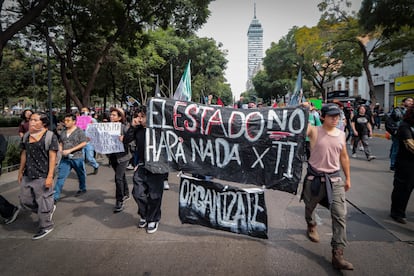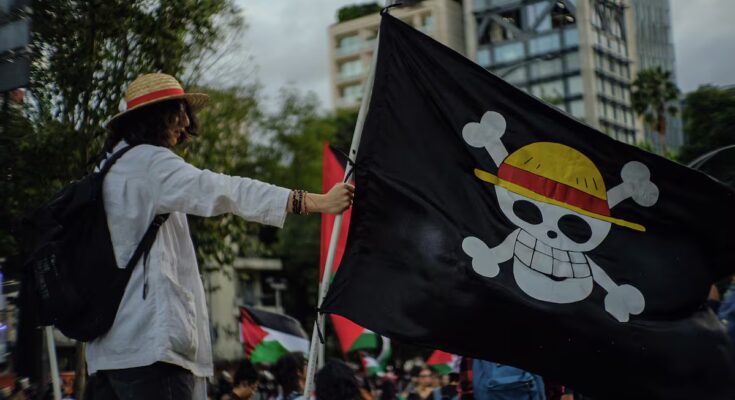The Mexican government has identified a network of coordinated accounts, opposition figures and international right-wing groups as the promoters of the march called this Saturday by young people who identify as part of generation Z. The coordinator of Infodemia, Miguel Ángel Elorza, presented this morning at the conference of President Claudia Sheinbaum a report that attributes the mobilization to a “complex digital strategy” with the participation of bots, influencers, politicians linked to the opposition and the entrepreneur Ricardo Salinas Pliego. The estimated spending on the digital campaign, according to the Elorza report, exceeds 90 million pesos in the last month and a half alone.
The president, who last week criticized and insisted on dismantling the movement, said Thursday that the mobilization has no authentic origin. “There may be young people who disagree with us and this is part of democracy, but it is very important to know how this mobilization was orchestrated. There is evidence that many of the initiators have nothing to do with generation Z, but that this is a political operation even financed from abroad,” Sheinbaum said. After the presentation of the investigation, the movement tweeted mockingly: “All the characters mentioned in the morning report to those millionaires.”
Elorza has been mapping the conversation on social media since early October and says the protest, which began as a nonpartisan call for the mandate to be lifted, has been amplified by newly created accounts that have shifted toward a narrative critical of the government. According to Elorza, the conversation was promoted by “actors with economic and media interests”, including people close to Salinas Pliego. It also highlights that the Atlas Network is behind the campaign, a network of more than 500 centers designed to spread far-right ideology, with a strong presence in Latin America and Spain.
Reconstruction
The chronology of the appeal begins on October 3, when the Azteca Noticias channel, of the Salinas Pliego television station, broadcast a report on the movement of Generation Z in several countries. Days later, influencer Carlos Bello criticized the government in a forum at the Chamber of Deputies. On October 7, Salinas Pliego shared the video of her speech. From that moment on, accounts with names like Generaciónz_mx, Revoluciónsmexicanos or Somosgeneraciónzmx began to emerge on social networks, calling for a march on November 15th.
Nearly 200 accounts spread mobilization content on TikTok, and at least 50 of these were created or had their first activity between October and November. On Facebook, 359 groups – 28 of them run by foreigners – started talking about the issue at the end of the month. Infodemia found that at least 20 pages that previously spread entertainment or travel content suddenly changed theme to promote the march or criticize the government.

The tone of the posts also changed as the weeks went by. Between 16 and 26 October the messages called for a “peaceful” protest to demand the revocation of the mandate. But starting from the 27th, images generated with artificial intelligence began to circulate showing the National Palace in flames. Then, after the assassination of the mayor of Uruapan, Carlos Manzo, on November 1, the calls shifted to the issue of insecurity. “Synchronically, communities and pages changed the reason for the march,” Elorza said.
The appeal was spread by figures such as the mayor of Cuauhtémoc, Alessandra Rojo de la Vega, former president Vicente Fox and the opposition movement Marea Rosa, which allegedly promoted the march from its networks.
The movement’s path crosses borders, in what Elorza called “the international right and its enterprises”. Atlas Network is highlighted there: “It has been linked to smear campaigns against progressive governments in Latin America,” the document states. In the case of Argentina, Fernando Cerimedo, head of digital campaigns of President Javier Milei, appeared as a collaborator of La Derecha Diario México, a portal created in 2024 by the Spanish journalist Javier Negre after receiving an invitation from Salinas Pliego himself.

Among the Mexican influencers identified by Infodemia, there are users with profiles unrelated to politics – dedicated to music, make-up or video games – who in recent weeks have started sharing messages in favor of the mobilization. “This is an artificial amplification campaign through audiovisual and emotional strategies aimed at young people,” Elorza said. While it did not say who financed the campaign, Infodemia insisted that “this is not a domestic effort.”
The survey comes two days before the Generation Z demonstration, which has generated widespread debate and expectations. The movement, driven by a wave of youth discontent, has toppled governments in other countries, but the absence of young people in Mexican networks calls into question the drawing power the demonstration will achieve. However, on Wednesday the president, together with the capital’s administration, protected the National Palace and other monuments in the Historic Center with metal fences, while Generation Z accounts in Mexico shared information on how to tear down the walls.



